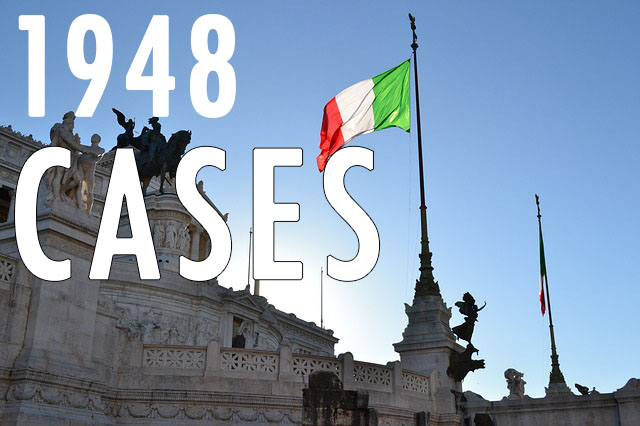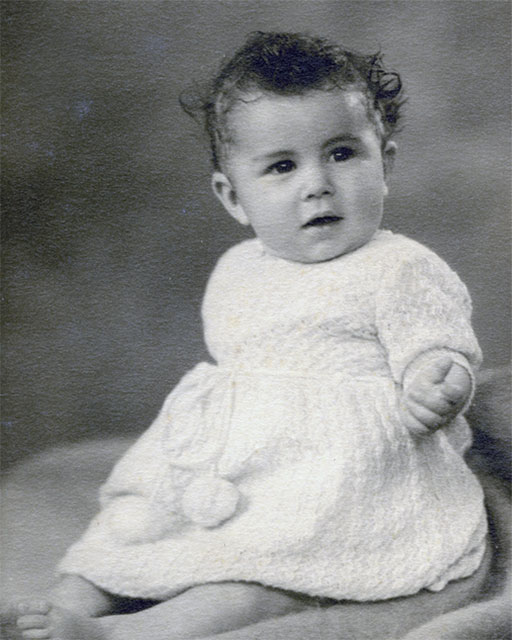
Are you interested in applying for Italian citizenship under Jure Sanguinis, or Italian citizenship by descent? In some cases, you may fall under a circumstance known as a “1948 case“. This can be a confusing route for some individuals who are trying to navigate these policies and understand how the entire application process works.
Below, we will break down each step of the 1948 court case process and highlight what actions you need to take to ensure that you are meeting all the proper requirements to successfully obtain Italian citizenship. We also want to compare the 1948 process with the more common administrative process so you can understand how the different citizenship application options work.
What Makes a 1948 Court Case?
To be successful through the judicial process, you need to make a case for your eligibility under the 1948 court case Italian law.
Here’s an example of a valid case:
Let’s say you have an ascendant in your direct Italian lineage who was a woman and gave birth. You’ll first want to see whether she gave birth before 1948 or after.
If she gave birth before 1948, it was not possible at the time for her to transfer her Italian citizenship to her child. This is because, before 1948, women were not able to transfer lineage in the same way that men could.
If she gave birth during or after 1948, then her child would have been able to receive her Italian citizenship as women were made equal to men during this year. After these rights were established, anyone born from an Italian-born woman or from a woman of Italian descent has the right to become an Italian citizen.
If this case is similar to yours, you are put into the 1948 category. Since your family line tracing your lineage to Italy involves a woman giving birth before the new set of rights were established in 1948, you need to apply for citizenship with the Italian courts, rather than being able to go through a consulate as is the standard means.
Need help figuring out your case? Not sure how you need to apply for Italian citizenship? Our Italian citizenship lawyer can help you find the best solution.
What is the 1948 Route?
Now, let’s talk a little bit about what the 1948 route entails, as opposed to the administrative route. You don’t need to worry, as the 1948 route does not mean that you are going to have a longer or more difficult process than the standard means of acquiring citizenship. In come cases it is actually faster.
Some of the biggest differences that you’ll see between the 1948 or judicial option and the administrative option are that you have to additionally petition the Italian Court of Rome and ask to be granted Italian citizenship by way of the 1948 process. With the administrative process, you have to submit documents to a comune or an Italian consulate who can validate your application for citizenship.
There is a specific document you need to file a claim before the Tribunale Ordinario di Roma – Sezione Civile (Civil Court of Rome). Once this document is accepted, you will be allowed to present your case in front of a judge.
This does mean that an official lawsuit with a court hearing will be required, however you do not have to travel to Italy and attend the hearing. The legal team at IDC will have a lawyer attend your court hearing to represent you on your behalf.
During these court proceedings, it is up to the Roman court to decide if you do in fact have a right to citizenship under the 1948 court case. If they determine that you are eligible for citizenship by descent, our attorney will argue that the 1948 court cases, which became an amendment to the Italian Constitution, need to be applied retroactively to your case.
Success Rates
Many people get worried when they think about having to go to court. And while it can sometimes seem like an intimidating process, it has very high success rates. For over a decade, the Italian Court has ruled positively on hundreds and hundreds of citizenship cases like this. In fact, Italy no longer tries to provide counterarguments. This is because women’s rights have generally been retroactively fitted to laws and considered a Case Law, giving positive rulings strong precedence over future cases.
How Does the Actual Proceeding Work?
Perhaps the one thing people want to know the most is how this judicial process works, and what the details are of the court proceedings. We put together this step-by-step guide that details how you can file your claim for Italian citizenship with a 1948 case and claim citizenship by descent. This guide also includes how to register for Italian citizenship after you’ve completed the first part and have been successfully recognized. Keep in mind that families can file a claim together through a shared ancestor to cut expenses and expedite the process for everyone.
If you need help with any part of this process, our friendly team can provide assistance and completion packages to ensure that all of your documents are prepared the right way, and you know what to expect and how to properly navigate the Italian citizenship process.
STEP 1: Collect and present all vital record documents
You need to find every important document detailing the life events of all of your ancestors that will trace your lineage back to Italian descent.
This means everything from birth and death certificates to marriages, divorces, immigration, name change information, and naturalization records, wherever applicable.
Keep in mind that you do not need to provide non-lineage documents. You don’t need to find documents for the spouses or family members of the specific ancestor for whom you are gathering information. However, you are by no means excluded from providing these documents as well. If you feel that the more documents to support your case, the better, you are certainly able to include them provided your direct lineage information is sufficient.
STEP 2: Legalize every document
All of the documents that you gathered to create a paper trail between you and your lineage need to be legalized if they are non-Italian documents. For example, if your grandparent’s death certificate is from the United States and not Italy, it needs to be apostille certified. An apostille is a stamp signifying the official authentication of a public document that is originally foreign. Once it has this stamp, it will be seen as legal under the Italian government as well.
Not every foreign document needs an apostille stamp. If you or a direct ascendant were naturalized in the United States, and you receive these naturalization records from the USCIS, you do not need to get an apostille stamp.
STEP 3: Get your documents certified translated
Any documents that are not originally in Italian need to be translated for the Italian government to look at and approve them. This is because the only official language of the country is Italian, so any documents in other languages will either not be understood by officials or not be accepted at all.
Fortunately, there are a couple of ways that you can get your documents translated (and have them certified for accuracy) before you’re able to present them at the judicial hearing:
- If you have a local Italian consulate, you can apply for a process known as Certificazione di Conformita di Traduzione. Look for your local Consular Fees and find the trimestral chart to determine the cost of this process. You will receive a plain translation as part of this service. Some consulates may also provide a Certificate of Translation Request Form upon completion.
- Get your translations certified by an official in the Italian judicial system. This can be done by way of Asseverazione delle Traduzioni. First, you need to translate your documents with a professional translator. Then, that translator will need to swear before the court in Italy to the accuracy of their translations.
Again, not all documents around the world need to be certified translated, but most do. If you are curious about your specific documents, we can help you figure out the best course of action for translation.
STEP 4: Get an Italian attorney who can represent you in an Italian court
It is highly recommended that you work with an Italian legal professional who is very familiar with Italian civil law, especially when it comes to the 1948 court cases. Many of these kinds of cases are very particular and individual, so they aren’t like many common civil cases out there. That is why it’s important to find someone with expertise on the subject.
Another good reason to invest in an Italian lawyer is that you can trust this person to represent you at the hearing. That way, you won’t have to attend yourself if you don’t want to or if you have no means of getting to Rome.
We can provide you with an experienced Italian attorney who knows the ins and outs of this 1948 judicial process and can boost your chances of success with your case.
STEP 5: Sign for Power of Attorney
If you decide to go with an Italian lawyer, your next step is to sign a POA. Get this document notarized and then send it to your lawyer. If you have any family members petitioning alongside you, they will also have to grant Power of Attorney to the same representative in a notarized note.
Do you have children who are minors, and who are also petitioning to qualify for 1948 citizenship? They need to sign a POA too – but you need to sign on their behalf. Each petitioner needs to sign an individual POA on behalf of all of their minor children, and so on.
STEP 6: Mail all of your certified documents and original signed POAs to your attorney
Every single document is vital and required to support your case, including the POAs. All of this needs to be sent to your attorney so they can complete the proper steps necessary on their end to help you win your case.
It is very important to know that you must send original documents only, not photocopies. Photocopies are not valid and will not be accepted.
STEP 7: Start your petition
Now that your lawyer has all of your documents, they can start your petition process. They will work with you to go through all of the details you need to know to establish a strong case, and they may ask you questions about your lineage so you can be equipped with as many facts as possible. Your lawyer will also help you become familiar with specific Italian laws and policies that will be cited to help you win your petition.
STEP 8: File your petition online
With the advent of technology, it’s much easier and quicker to get your petition started than it was decades ago. Your lawyer can e-file all of your documents by submitting them to the Civil Court of Rome online, where it will also be sent to the Italian Ministry of Interior’s Office.
STEP 9: Get an assigned judge, obtain your case number, and wait for your hearing date
After everything has been filed and submitted, you must wait for the court to assign you a case number and a judge. This process is usually a waiting game, as it can take a couple of months to a year for everything to come together. Then, once these are assigned, you will need to wait a little bit longer to get your hearing date.
When the day of your hearing has finally arrived, the judge will do a preliminary evaluation of your case to address the main points and to get any clarification from the lawyer if needed. Usually, one hearing will suffice, but sometimes a follow-up hearing may need to be scheduled. In either case you will receive a final judgment a few months after the final hearing.
Your final judgment will explain why you have or haven’t been granted the entitlement to Italian citizenship. In the majority of cases, the judge will grant in favor of you becoming a citizen, and then the vital statistics office will record this information and make it official.
STEP 10: Registering vital records and sealing the deal!
Finally, you are in the final steps to achieving full Italian citizenship. After the hard part is over and the judge has ruled in favor of your petition, you will receive a court order. This means that all of the vital records you submitted as part of your case will need to be registered with whatever comune, or Italian municipality, in which your ancestor was born.
The court order is the official document that you need to complete this final step.
Many comuni are different and may have different sets of policies and procedures that you will need to follow to correctly complete this process. In most cases, you will need to register with the comune where your ancestor was born, and you cannot choose another municipality.
Being Recognized as a Citizen
You will complete the process feeling like you have achieved becoming an official citizen of Italy. Being a citizen by descent means that you are retroactively an Italian citizen from birth, entitling you to all of your vital records as well as other benefits and rights given by the Italian government.
Make sure to file your vital records with the Italian government, as this will make it easier for any future spouses and children you have to register for citizenship as well.
If you are looking for more ways to learn about the processes and documents needed to become an Italian citizen, our professional team can help you out. We hope the above information has been able to assist you in your understanding of the judicial process as an alternative way to apply for Italian citizenship.
This page was last updated by Jason LoPresti
Additional Resources:
- Renew Italian passport
- Apply for Italian dual citizenship
- Dual citizenship Italy and Brazil, and South America
- Italian citizenship by descent South Africa
- Dual citizenship Italy and Canada
- Italian citizenship jure sanguinis South Africa
- Italian citizenship by bloodline
- Italian citizenship through marriage
- Dual citizenship Italy and UK
- Italian citizenship in Australia
- Benefits of getting Italian citizenship
- requirements for citizenship in Italy
- Italian citizenship by using great grandparents
- Becoming an Italian citizen





